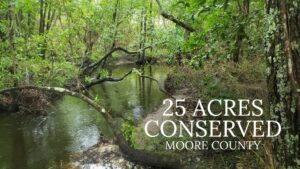
by Darrien Staton, LandTrust intern summer 2015
July 9, 2015

Each of us views nature in a different way, based on our upbringing, life experiences, occupation, and any number of other factors. When first observing nature, it may simply seem like endless woods and shrubs blanketing the landscape. If you look more closely, you may notice birds in the trees or a spider forming a web directly overhead. If you take a deep breath, you may get a whiff of the sweet scented pine trees that cover the land. When you close your eyes, you may hear the buzz of an American Bumblebee passing by. By taking the time to examine your surroundings using all of your senses, you will find that nature is more than overgrown fields, elusive animals, and innumerable insects. Nature is a work of art.

During my experience as an intern with The Land Trust for Central North Carolina, I have seen some amazing places. Recently I had the opportunity to photograph a property owned by The LandTrust in Montgomery County. During the outing I was taken to Hidden Lake, which happens to be the most beautiful lake I have ever seen. I heard the chirping of birds in the trees and all around were brightly colored dragonflies hovering over the marsh. However, the true beauty was in the landscape on the far side of the lake. It looked as if it was a postimpressionism painting by Paul Cezanne or Vincent Van Gogh. The lake reflected the various shades and tones of green from the shoreline like a palette knife painting—each stroke of color stronger than the last. I was at a loss for words, so I took a photograph.
As an artist and photographer, I look at nature differently than most. I observe things that many individuals overlook. I treat my surroundings like a work of art or a painting. Where some people may see overgrown weeds, I see life and energy.

When I come across something I might like to photograph, I use an artistic thinking process. For example, imagine coming across a flower on a hike. The first thing I will do is observe the flower itself. What color is it? How much space does it take up? Then I look more widely around the space. Where is the flower located? How does it compare to its surrounding environment? What makes this flower special? When you take the time to think in this way, you begin to see the flower as more than just a simple plant. You may notice dew droplets that slide down the curved leaves of the flower or a rainbow of perfectly blended colors within its petals. Not only do you take in the beauty of the flower, but you recognize its significance to its surroundings. Perhaps it’s the last standing flower in a clear cut forest. The flower now becomes a symbol of beauty that the land once had or a call for action to conserve other lands and protect them from clearcutting.

Viewing nature as an artist views his canvas can be a very powerful tool. Whether you are a photographer, illustrator, or just a nature enthusiast, insightful observation of nature can become a tool that leaves you with more than just ticks or debris in your shoes. It can become a truly rewarding experience, leaving you in a state of awe. Next time you are in nature, I encourage you to view your surroundings in this way. Take in what you normally would overlook, and it will enhance your experience in a way you never knew possible.